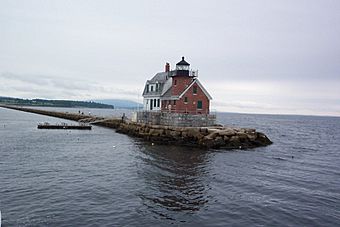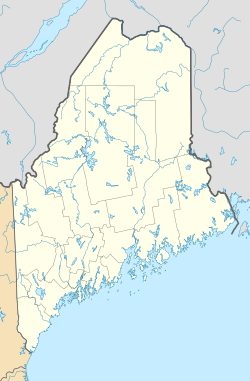Rockland Breakwater facts for kids
Quick facts for kids |
|
|
Rockland Breakwater
|
|

View of the lighthouse and breakwater
|
|
| Location | South of Jameson Point, Rockland, Maine |
|---|---|
| Area | 0.4 acres (0.16 ha) |
| Built | 1880 |
| Built by | US Army Corps of Engineers |
| NRHP reference No. | 03000203 |
| Added to NRHP | April 11, 2003 |
The Rockland Breakwater is a long, strong wall built in the water. It helps protect the harbor of Rockland, Maine. This amazing wall is over 4,000 feet (about 1,200 meters) long! It was built in the 1890s by the United States Army Corps of Engineers. They used tough granite rock found nearby. The breakwater makes the harbor a safe place for ships during big storms. In 2003, it was added to the National Register of Historic Places. This means it is an important historical site.
Contents
Why the Breakwater Was Built
The city of Rockland is located on the coast of Maine. Its harbor was a popular spot for ships to stop. It was known as a good place to hide from bad weather. However, the harbor faced east. This meant that strong storms, especially "Nor'easters" (storms with winds from the northeast), could still cause problems for ships.
Protecting Ships from Storms
Big storms in the 1850s showed that the harbor needed more protection. Ships were not as safe as people thought. So, in 1880, the government decided to build a breakwater. The United States Army Corps of Engineers started the project. They worked on it from 1880 to 1900. The lighthouse you see at the end of the breakwater was added later, in 1902.
How the Breakwater Was Built
The Rockland Breakwater starts at Jameson Point. This point marks the northern part of the harbor's entrance. The breakwater stretches out for about 4,364 feet (1,330 meters). That's almost a mile long!
Materials and Design
The breakwater is made from granite rock. This rock was dug up from quarries right there in Rockland. The wall is shaped like a ramp on one side. The side facing the ocean slopes more gently. This helps it stand up to the powerful waves. The top of the breakwater is about 43 feet (13 meters) wide. Its base, which is underwater, is much wider, about 175 feet (53 meters) across. The part you can see is made of carefully placed granite blocks. About 700,000 tons of rock were used to build it. It's special because it used only local materials, which was rare for projects like this back then.
Images for kids




